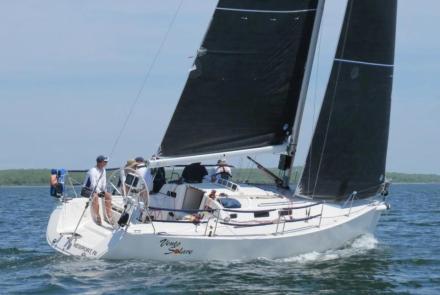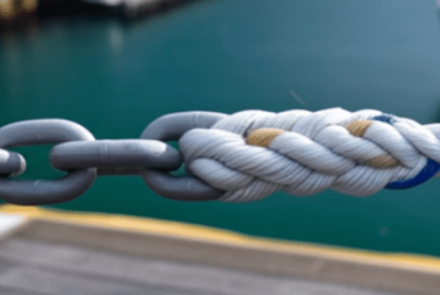Return from Bermuda: The Art of Sailing Slow
The return journey from Bermuda can, and should be, a fun passage and a very rewarding experience. For those making an ocean passage for the first time, it can be a great experience leading to a lifetime of offshore sailing.
The Bermuda passage also is a passage through waters that deservedly are deemed among the world's more difficult because of the Gulf Stream and the rapid movement of weather systems off the East Coast. This paper is intended to give delivery crews some ideas on how to manage the risks and increase the pleasure of the trip.
CREW TRAINING
An issue that must be thought through is the experience and training of the return crew. The less experience and athletic ability in the return crew, the more conservative your sailing has to be. If a crew member has not been offshore before, the higher the risk of seasickness and being incapacitated.
Very important is getting the idea that the mindset of the crew must be different than during the race. During the race, the whole objective is to sail as fast as you can. To this end the crew is large and selected for experience that allows the boat to be pushed to the limit. On the return trip the crew is almost always smaller and less experienced. Absence of weight on the rail has a material effect on the boat’s behavior including how much sail it is safe to carry. Very importantly, the ability of the crew to respond to needed sail changes is reduced, and the way these changes are done has to be executed differently. While the race crew has done hours of preparation by doing racing sail changes, the delivery crew has not.
To offset these crew issues, training is important. If possible, attendance by the return crew at a certified Safety at Sea Seminar is an excellent idea. At a minimum they will gain an understanding of offshore issues. Also helpful is doing as much sailing on the boat prior to the trip. We have found joint training days with both race and return crews works well. You should practice maneuvers that are done on ocean races but not on windward/leewards. This would include use of reaching sails, jib changes, reefing, use of drogues, and storm sails. Additionally during these sessions the return crew can learn the boat and key stowage plans.
SAILING SLOW
The sensible solution to confronting crew and weather issues is to change how you sail the boat. Think through each maneuver and plan how to do it with maximum SAFETY and execution by a small crew. For example, while racing we don't hesitate to wait till the last moment to do a jib change. In delivery mode we change jibs before it is blowing hard lest it be beyond the ability of the crew to do safely later. Also, we apply the adage: “reef when you first think about it.” You will find you lose very little speed even when you change jibs in anticipation of bad weather and reef when you first think about it.
You must think about how to sail slowly to sail safely. Following are a number of ideas on how to do this:
CHANGE YOUR RIG
The goal is to be able to do as many sail changes as possible without leaving the cockpit. The way to do this is very dependent on the way each boat is rigged. On many race boats reefing the main is done by sending men forward to the mast to lower the main, hook new clew ring to the horns, and tension the halyard. Of course, if the sail only has the bolt rope, the section that is lowered can be hard to control. In a nasty seaway, all this is not easy! If the main halyard can be lead aft for the trip and reefing lines pre-rigged for each reef and also led aft, the job can be done safely with no one leaving the cockpit. This only works if the delivery main has slides.
A final thought on mains is to have a third reef installed in your delivery main. I have found the only safe way to set the third reef is first to put in the second reef, then lower the main and relead the first reef lines through the third reef cringles, and finally rehoist the main. The third reef can be used whenever wanted, and you significantly reduce sail without the all-hands drill of changing to the trysail. It is particularly valuable to use the third reef when it blows so hard you have no headsail. When the third reef is used the center of effort of the main moves pretty far forward so chance of broach is reduced.
Management of headsails is more difficult. The best solution is to install a roller furler for the trip. On many race boats this is not an option. Next best is to remove the head foil and use a jib with hanks. The hanked-on sail can be lowered by a small crew without losing control of the sail. Changing is still hard so it makes sense to have a relatively small jib that can handle a broad wind range. Having hanks on your storm jib will give you a broad range when you can have some headsail available.
You also strongly should consider running before the wind and seas during foredeck evolutions if you have sea room, to let your crew do changes with a better motion, lower apparent wind and a flat deck.
ANTICIPATE THE WEATHER
On a return trip you are sailing toward some pretty strong weather most of the time because of the Gulf Stream. On the return the wind builds gradually as you get closer to the North Wall of the Stream. It is easy to get lulled into not shortening early enough, and then finding yourself overpowered in nasty seas when it might be dangerous to shorten given your crew numbers and experience.
If in doubt, the best strategy is to shorten early. You can always motor sail for a bit if underpowered.
The same is true of other weather events which can be anticipated. For example, if a front is expected as you cross the stream, slow down to let the weather go by. Avoid being in the stream with the wind against the current while delivering.
There are a lot of different things that can be done to handle the issues discussed in this paper. The important thing is to plan ahead, practice, and understand your sail handling limitations so you can protect yourself and your crew.
The Bermuda Return Passage can be a wonderful experience, if you know how to sail the boat!
CCA Contact: Larry Glenn




